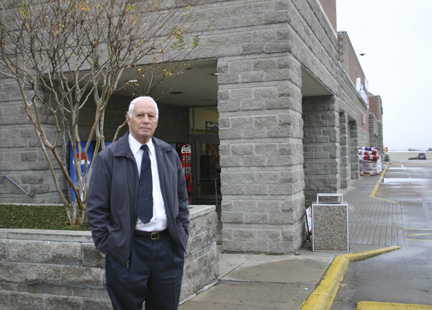Stopped at a red light at Meadowbrook Drive and Oakland Boulevard, Wanda Conlin turned her head to see a “clean and attractive” woman standing beside her car.
 “I thought she needed directions, but when I rolled down my window she was asking for a dollar for milk,” the Eastside newswoman said. “It never stops!” Norman Bermes, a small-business owner and Woodhaven resident, has heard it all before — stories of people avoiding Lancaster Avenue area businesses because of panhandlers. He told about entering a grocery store off Highway 360 one day to see four women driving off to avoid a panhandler. “They weren’t going to get out of their car — they were going to take their business somewhere else if this guy didn’t leave,” he said. Annoyed, Bermes went inside to speak with the manager of the store.
“I thought she needed directions, but when I rolled down my window she was asking for a dollar for milk,” the Eastside newswoman said. “It never stops!” Norman Bermes, a small-business owner and Woodhaven resident, has heard it all before — stories of people avoiding Lancaster Avenue area businesses because of panhandlers. He told about entering a grocery store off Highway 360 one day to see four women driving off to avoid a panhandler. “They weren’t going to get out of their car — they were going to take their business somewhere else if this guy didn’t leave,” he said. Annoyed, Bermes went inside to speak with the manager of the store.
“The manager walked out and told the man to leave, but he just went next door to continue begging for money.” Bermes said he believes the scene is repeated too often on the East Side and that local businesses are suffering as a result. “Their presence is killing business in Fort Worth.” Bermes said angrily, “Panhandlers are intimidating; customers don’t want to worry about people sleeping all over town. They would rather go drive out to Arlington than shop where they don’t feel safe.”
Nine months after city leaders and police officials sat down with angry Eastside residents and business owners to talk about problems caused by the area’s large homeless population, Bermes and others feel that little progress has been made. Business operators such as Suzette Watkins at the Riverside Kennel say they are losing substantial amounts of business to other neighborhoods because of panhandlers. The city’s long-term plan for the homeless, four years after the planning process started, still hasn’t been completed. And so Eastside leaders are working on their own partial solutions — like Bermes’ signs.
Bermes and Conlin went to city hall and asked city staffers for help in making simple signs to post at local businesses. Bermes said the placards are “nothing but an 8×11 sign that reads, ‘Please do not give money to the vagrants,’” but he believes they have helped. “Just saying to people, ‘Get out,’ is not what we’re doing,” he explained. “We’re saying, ‘Here’s an alternative to what you’re doing, which is illegal.’” At the meeting in March, Lancaster residents and business owners aired their complaints over the problems they felt were caused by the city’s policy of concentrating its homeless centers and service agencies in one area. Since the meeting, arrests in the Lancaster Avenue area have doubled.
Police spokesman Lt. Dean Sullivan said that since then, police have made at least 670 arrests in the area, half of them at one shelter alone. By focusing patrolling and increasing enforcement tactics, including using the Central Division Zero Tolerance Team in the area, he said, crime has decreased by 14 percent. But sustaining that progress, Sullivan said, will require other resources outside the police department. “We are only a small piece of the solution,” he said. “We will not be able to simply arrest our way out of this situation.”
A lot of work goes into dealing with homelessness in Fort Worth. But in some Eastsiders’ opinions, the city has gone too far toward helping homeless people without also helping those who have to deal with them. “The number of homeless has increased from 1,500 to 4,000 [in about the last decade] because there is no incentive for them to leave,” Conlin said. “Fort Worth has provided everything for them. The homeless can ride out on a bus, sell their blood at the plasma center, then take that money and buy liquor across the street. It’s getting out of hand.” After dealing repeatedly with lewdness, public intoxication, and homeless people trespassing at her business, kennel owner Watkins had had enough. It wasn’t until she sent numerous e-mails and made countless phone calls to the police and Mayor Mike Moncrief that Watkins began to see any results.
“Once I sent pictures [of problems at her business] to the mayor, he finally got the police force to enforce ordinances and laws,” she said. “They certainly cleaned up my corner of Lancaster, but I screamed and yelled until progress was made. I don’t think you should have to do that. The problem should be taken care of with one nice e-mail, but you literally have to be engaged in a part-time job to get somewhere.” Otis Thornton, the city’s homeless coordinator, is trying to move the homeless debate forward. The Mayor’s Advisory Commission on Homelessness, formed in October 2005, is focusing on developing a 10-year plan of policies and methods for addressing homelessness in Fort Worth. “Although the plan is not quite finished, we are hopeful that we will have something to take to city council in June of 2008,” Thornton said. “The 10-year plan has been a large focus, but along the way we have taken advantage of opportunities for early wins and successes.”
One of those successes came earlier this year when the Texas Legislature passed a bill filed by State Rep. Marc Veasey, a Fort Worth Democrat, allowing cities to regulate liquor consumption around homeless shelters and substance abuse treatment centers. The city council then passed an ordinance making it illegal to possess open liquor containers or publicly consume alcohol within 1,000 feet of a shelter. The idea, Thornton said, is to keep people from hanging around homeless shelters to drink — and to help solve the problems of kids who live at shelters having to pass by a line of drunks to get from the school bus to the shelter door.
Additionally, Thornton is working on strategies to increase the availability of housing options other than shelters. Supportive housing “links quality affordable housing with the supportive services that disabled and chronically homeless people need to be successful,” he said. Agencies like the Presbyterian Night Shelter are already moving some people into supportive housing. “We offer emergency shelter and transitional housing,” said shelter director Carol Klocek. “The Presbyterian Night Shelter will never turn away anyone who is in need of our services. It has caused a lot of controversy in the community because people feel like we should set restrictions. There is a lot of fear [concerning the homeless], but the reality is that most of them are really good folks that are just trying to live their lives like anyone else.”
Bermes and others say they sympathize with the problems of homeless people, but they also think those problems shouldn’t absolve them of responsibility for their actions. “Life is not a free ride,” Bermes said. “I know people who have hit rock bottom and picked themselves back up. If you have the willingness to do so, then you will be OK.”











